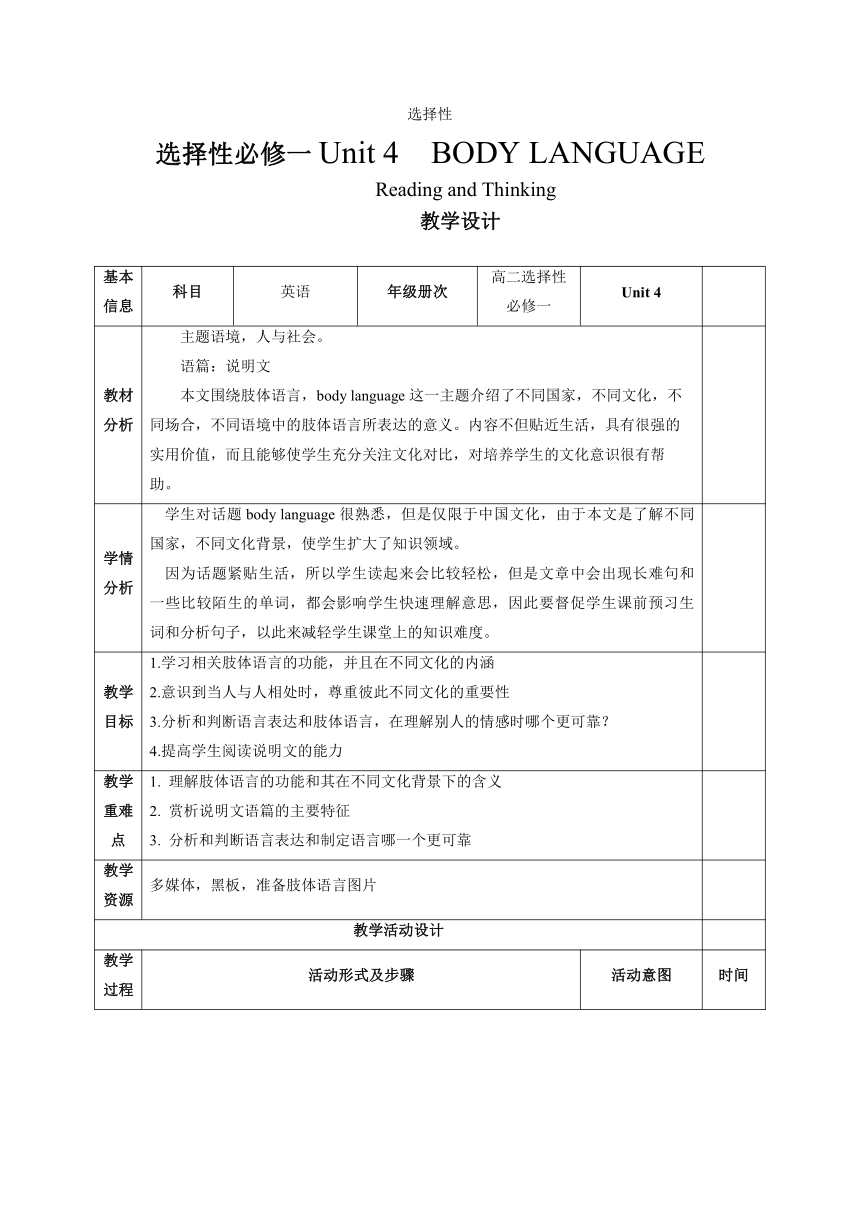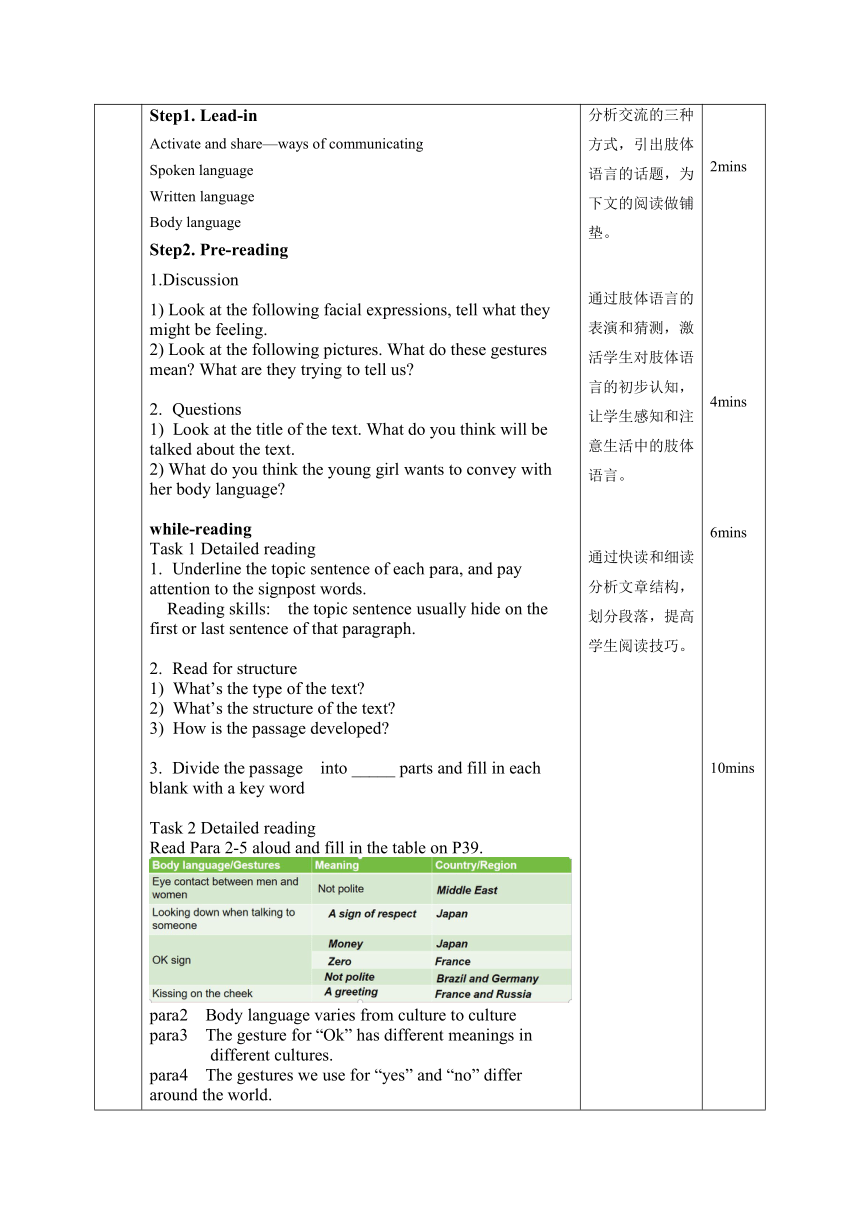人教版(2019)选择性必修 第一册Unit 4 Body Language Reading and Thinking教学设计
文档属性
| 名称 | 人教版(2019)选择性必修 第一册Unit 4 Body Language Reading and Thinking教学设计 |

|
|
| 格式 | docx | ||
| 文件大小 | 93.4KB | ||
| 资源类型 | 教案 | ||
| 版本资源 | 人教版(2019) | ||
| 科目 | 英语 | ||
| 更新时间 | 2024-03-12 09:37:17 | ||
图片预览


文档简介
选择性
选择性必修一Unit 4 BODY LANGUAGE
Reading and Thinking
教学设计
基本信息 科目 英语 年级册次 高二选择性 必修一 Unit 4
教材分析 主题语境,人与社会。 语篇:说明文 本文围绕肢体语言,body language这一主题介绍了不同国家,不同文化,不同场合,不同语境中的肢体语言所表达的意义。内容不但贴近生活,具有很强的实用价值,而且能够使学生充分关注文化对比,对培养学生的文化意识很有帮助。
学情分析 学生对话题body language很熟悉,但是仅限于中国文化,由于本文是了解不同国家,不同文化背景,使学生扩大了知识领域。 因为话题紧贴生活,所以学生读起来会比较轻松,但是文章中会出现长难句和一些比较陌生的单词,都会影响学生快速理解意思,因此要督促学生课前预习生词和分析句子,以此来减轻学生课堂上的知识难度。
教学目标 1.学习相关肢体语言的功能,并且在不同文化的内涵 2.意识到当人与人相处时,尊重彼此不同文化的重要性 3.分析和判断语言表达和肢体语言,在理解别人的情感时哪个更可靠? 4.提高学生阅读说明文的能力
教学重难点 理解肢体语言的功能和其在不同文化背景下的含义 赏析说明文语篇的主要特征 分析和判断语言表达和制定语言哪一个更可靠
教学资源 多媒体,黑板,准备肢体语言图片
教学活动设计
教学过程 活动形式及步骤 活动意图 时间
Step1. Lead-in Activate and share—ways of communicating Spoken language Written language Body language Step2. Pre-reading 1.Discussion 1) Look at the following facial expressions, tell what they might be feeling. 2) Look at the following pictures. What do these gestures mean What are they trying to tell us Questions Look at the title of the text. What do you think will be talked about the text. 2) What do you think the young girl wants to convey with her body language while-reading Task 1 Detailed reading Underline the topic sentence of each para, and pay attention to the signpost words. Reading skills: the topic sentence usually hide on the first or last sentence of that paragraph. Read for structure What’s the type of the text What’s the structure of the text How is the passage developed Divide the passage into _____ parts and fill in each blank with a key word Task 2 Detailed reading Read Para 2-5 aloud and fill in the table on P39. para2 Body language varies from culture to culture para3 The gesture for “Ok” has different meanings in different cultures. para4 The gestures we use for “yes” and “no” differ around the world. There are also difference when we meet or apart. para5 Some gestures seem to have the same meaning everywhere. para6 Some body language has many different uses --- smile Can you think of some other uses of smiling Task 3 Learning the text structure Function of body language Different meanings of gestures Different uses of smile Post -reading Task 1 Fill in the blanks Task 2 Group work What advice on body language can you give a foreign friend on his/her first trip on China When people meet When talking with people When sitting/standing Assignment Give some advice to your foreign friends on proper body language use when they have intercultural communication. Writing: 你的美国笔友John下个月第一次来中国参加交换生活动,将在中国待两周时间。给你发e-mail,询问在中国期间与人交往注意哪些肢体语言含义和禁忌。请你给他回信,包含以下要点: 1.表示欢迎他的到来; 2.介绍中国常见肢体语言含义和禁忌; 3.期望对他有帮助。 注意:1.可增加细节,以使行文连贯; 2.字数:80词左右 分析交流的三种方式,引出肢体语言的话题,为下文的阅读做铺垫。 通过肢体语言的表演和猜测,激活学生对肢体语言的初步认知,让学生感知和注意生活中的肢体语言。 通过快读和细读分析文章结构,划分段落,提高学生阅读技巧。 具体阐述特定肢体语言在中国文化中表达的特定含义,加深对肢体语言的理解,提高对肢体语言的文化差异的敏感度 文本知识与学生真实生活相关联,实现读有所有 2mins 4mins 6mins 10mins 5mins 5mins 8mins
板书设计与教学反思 课后反思: 本节课在文本解读上由表层信息,逐渐过渡到深层信息。在活动设计上体现了教学理论与教学实践相结合。在学生核心素养培养上,通过阅读,获取信息,处理信息,传达信息,提高学生的语言能力。通过运用预测,猜测,快速阅读等策略提高学生的学习能力。通过讨论,思考,推断等问题的设计,提高学生的思维品质,把语言知识学习与获取信息结合起来。 课堂活动的设计旨在学生批判性思维,给学生创造机会去分析对与错,结果不重要,过程一定要重视。此外,让学生了解说明文具有独特的语言结构和文体特征。 在讨论的过程中,都是只有固定几个人在表达,不是大范围学生参与,但是值得说的是他们讨论的过程还是很热烈的。此环节对学生有难度,学生们只能找到课文的位置,提炼总结表达能力还是有差距的,因此尽量给他们时间小组讨论,让他们进行知识互补。
选择性必修一Unit 4 BODY LANGUAGE
Reading and Thinking
教学设计
基本信息 科目 英语 年级册次 高二选择性 必修一 Unit 4
教材分析 主题语境,人与社会。 语篇:说明文 本文围绕肢体语言,body language这一主题介绍了不同国家,不同文化,不同场合,不同语境中的肢体语言所表达的意义。内容不但贴近生活,具有很强的实用价值,而且能够使学生充分关注文化对比,对培养学生的文化意识很有帮助。
学情分析 学生对话题body language很熟悉,但是仅限于中国文化,由于本文是了解不同国家,不同文化背景,使学生扩大了知识领域。 因为话题紧贴生活,所以学生读起来会比较轻松,但是文章中会出现长难句和一些比较陌生的单词,都会影响学生快速理解意思,因此要督促学生课前预习生词和分析句子,以此来减轻学生课堂上的知识难度。
教学目标 1.学习相关肢体语言的功能,并且在不同文化的内涵 2.意识到当人与人相处时,尊重彼此不同文化的重要性 3.分析和判断语言表达和肢体语言,在理解别人的情感时哪个更可靠? 4.提高学生阅读说明文的能力
教学重难点 理解肢体语言的功能和其在不同文化背景下的含义 赏析说明文语篇的主要特征 分析和判断语言表达和制定语言哪一个更可靠
教学资源 多媒体,黑板,准备肢体语言图片
教学活动设计
教学过程 活动形式及步骤 活动意图 时间
Step1. Lead-in Activate and share—ways of communicating Spoken language Written language Body language Step2. Pre-reading 1.Discussion 1) Look at the following facial expressions, tell what they might be feeling. 2) Look at the following pictures. What do these gestures mean What are they trying to tell us Questions Look at the title of the text. What do you think will be talked about the text. 2) What do you think the young girl wants to convey with her body language while-reading Task 1 Detailed reading Underline the topic sentence of each para, and pay attention to the signpost words. Reading skills: the topic sentence usually hide on the first or last sentence of that paragraph. Read for structure What’s the type of the text What’s the structure of the text How is the passage developed Divide the passage into _____ parts and fill in each blank with a key word Task 2 Detailed reading Read Para 2-5 aloud and fill in the table on P39. para2 Body language varies from culture to culture para3 The gesture for “Ok” has different meanings in different cultures. para4 The gestures we use for “yes” and “no” differ around the world. There are also difference when we meet or apart. para5 Some gestures seem to have the same meaning everywhere. para6 Some body language has many different uses --- smile Can you think of some other uses of smiling Task 3 Learning the text structure Function of body language Different meanings of gestures Different uses of smile Post -reading Task 1 Fill in the blanks Task 2 Group work What advice on body language can you give a foreign friend on his/her first trip on China When people meet When talking with people When sitting/standing Assignment Give some advice to your foreign friends on proper body language use when they have intercultural communication. Writing: 你的美国笔友John下个月第一次来中国参加交换生活动,将在中国待两周时间。给你发e-mail,询问在中国期间与人交往注意哪些肢体语言含义和禁忌。请你给他回信,包含以下要点: 1.表示欢迎他的到来; 2.介绍中国常见肢体语言含义和禁忌; 3.期望对他有帮助。 注意:1.可增加细节,以使行文连贯; 2.字数:80词左右 分析交流的三种方式,引出肢体语言的话题,为下文的阅读做铺垫。 通过肢体语言的表演和猜测,激活学生对肢体语言的初步认知,让学生感知和注意生活中的肢体语言。 通过快读和细读分析文章结构,划分段落,提高学生阅读技巧。 具体阐述特定肢体语言在中国文化中表达的特定含义,加深对肢体语言的理解,提高对肢体语言的文化差异的敏感度 文本知识与学生真实生活相关联,实现读有所有 2mins 4mins 6mins 10mins 5mins 5mins 8mins
板书设计与教学反思 课后反思: 本节课在文本解读上由表层信息,逐渐过渡到深层信息。在活动设计上体现了教学理论与教学实践相结合。在学生核心素养培养上,通过阅读,获取信息,处理信息,传达信息,提高学生的语言能力。通过运用预测,猜测,快速阅读等策略提高学生的学习能力。通过讨论,思考,推断等问题的设计,提高学生的思维品质,把语言知识学习与获取信息结合起来。 课堂活动的设计旨在学生批判性思维,给学生创造机会去分析对与错,结果不重要,过程一定要重视。此外,让学生了解说明文具有独特的语言结构和文体特征。 在讨论的过程中,都是只有固定几个人在表达,不是大范围学生参与,但是值得说的是他们讨论的过程还是很热烈的。此环节对学生有难度,学生们只能找到课文的位置,提炼总结表达能力还是有差距的,因此尽量给他们时间小组讨论,让他们进行知识互补。
